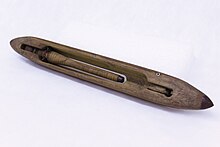
Back Létající člunek Czech Schnellschützen German Navedo Esperanto Lanzadera volante Spanish Spoletta volante Italian 나는 북 Korean Schietspoel Dutch Lançadeira voadora Portuguese Leteći čunak Serbo-Croatian Летећи чунак Serbian



The flying shuttle is a type of weaving shuttle. It was a pivotal advancement in the mechanisation of weaving during the initial stages of the Industrial Revolution, and facilitated the weaving of considerably broader fabrics, enabling the production of wider textiles. Moreover, its mechanical implementation paved the way for the introduction of automatic machine looms.
The brainchild of John Kay, the flying shuttle received a patent in the year 1733. Its implementation brought about an acceleration of the previously manual weaving process and resulted in a significant reduction in the required labour force. Formerly, a broad-cloth loom necessitated the presence of a weaver on each side, but with the advent of the flying shuttle, a solitary operator could handle the task proficiently. Prior to this breakthrough, the textile industry relied upon the coordination of four spinners to support a single weaver.
The widespread adoption of the flying shuttle by the 1750s dramatically exacerbated this labour imbalance, marking a notable shift in textile production dynamics.[1]
- ^ "History of technology". www.historyworld.net. Retrieved 2 November 2017.